Royal Hospital for Seamen
Romney Road, Greenwich, SE10 9LS
Medical dates:
Medical character:
Residential care
The Royal Hospital for Seamen at
Greenwich was founded by William III in 1694 in memory of his late wife
Queen Mary II, who had championed it. The Hospital was intended
to provide relief and support for disabled and destitute sailors of the
Royal Navy and their dependants.
The buildings were designed by Sir Christopher Wren, who had also designed the Royal Hospital in Chelsea for army veterans. Work began on the four 'courts' in 1696 and was finally completed in 1751, even though the first inmates had been admitted in 1705. The Hospital was four times the size of the Chelsea one, with room for 2044 Pensioners.
An infirmary building, west of King Charles Court, was added in 1769.
In 1806, for three days in January, Admiral Lord Nelson's body lay in state in the Painted Hall, prior to his burial at St Paul's Cathedral.
A single-storey building was erected between 1808 and 1810 to the west of the infirmary, and contained the 'Helpless Wards' for incurables.
By 1814 the Greenwich Hospital had 2710 inmates. However, by the mid 19th century, following a long period of peace and therefore less naval casualties, demand for admission had greatly diminished. Also, the system of 'Greenwich out-pensioners', begun in 1763, which enabled sailors to live with their families on an annual £7 pension instead of separately in the Hospital, proved extremely popular. Previously, while there had always been a waiting list for admission, by 1853 there were 400 vacant places; by 1860 these had grown to 1100 vacancies. A Royal Commission proposed an annuity to all existing inmates instead of an in-pension and, by 1865, 987 of the remaining 1400 Pensioners had left the Hospital.
The Hospital finally closed in 1869. By this time only six patients remained in the infirmary and 20 in the Helpless Wards.
In 1870 the Seamen's Hospital Society leased the infirmary block from the Admiralty as a hospital for merchant seamen and their families, which were then being housed on HMS Dreadnought.
In 1873 the 'court' buildings became the new home of the Royal Naval College, which moved to London from Portsmouth.
During WW2 the front of the King Charles Court received bomb damage, and the Admiral's house was badly damaged by a direct hit.
The College closed in 1998 when the Navy moved to the Joint Services Staff College, shared with the Army and the Royal Air Force.
The Greenwich Foundation - a management trust and registered charity - was created to maintain and look after the Grade I listed buildings for the public benefit. The site is now known as the Old Royal Naval College.
The Queen Anne, Queen Mary and King William Courts became the main campus for the University of Greenwich in 1999. The infirmary building (the former Dreadnought Seamen's Hospital) has become the Library for the University.
In 2001 the King Charles Court became the home of Trinity College of Music and the Jerwood Library for the Performing Arts.
The buildings were designed by Sir Christopher Wren, who had also designed the Royal Hospital in Chelsea for army veterans. Work began on the four 'courts' in 1696 and was finally completed in 1751, even though the first inmates had been admitted in 1705. The Hospital was four times the size of the Chelsea one, with room for 2044 Pensioners.
An infirmary building, west of King Charles Court, was added in 1769.
In 1806, for three days in January, Admiral Lord Nelson's body lay in state in the Painted Hall, prior to his burial at St Paul's Cathedral.
A single-storey building was erected between 1808 and 1810 to the west of the infirmary, and contained the 'Helpless Wards' for incurables.
By 1814 the Greenwich Hospital had 2710 inmates. However, by the mid 19th century, following a long period of peace and therefore less naval casualties, demand for admission had greatly diminished. Also, the system of 'Greenwich out-pensioners', begun in 1763, which enabled sailors to live with their families on an annual £7 pension instead of separately in the Hospital, proved extremely popular. Previously, while there had always been a waiting list for admission, by 1853 there were 400 vacant places; by 1860 these had grown to 1100 vacancies. A Royal Commission proposed an annuity to all existing inmates instead of an in-pension and, by 1865, 987 of the remaining 1400 Pensioners had left the Hospital.
The Hospital finally closed in 1869. By this time only six patients remained in the infirmary and 20 in the Helpless Wards.
In 1870 the Seamen's Hospital Society leased the infirmary block from the Admiralty as a hospital for merchant seamen and their families, which were then being housed on HMS Dreadnought.
In 1873 the 'court' buildings became the new home of the Royal Naval College, which moved to London from Portsmouth.
During WW2 the front of the King Charles Court received bomb damage, and the Admiral's house was badly damaged by a direct hit.
The College closed in 1998 when the Navy moved to the Joint Services Staff College, shared with the Army and the Royal Air Force.
The Greenwich Foundation - a management trust and registered charity - was created to maintain and look after the Grade I listed buildings for the public benefit. The site is now known as the Old Royal Naval College.
The Queen Anne, Queen Mary and King William Courts became the main campus for the University of Greenwich in 1999. The infirmary building (the former Dreadnought Seamen's Hospital) has become the Library for the University.
In 2001 the King Charles Court became the home of Trinity College of Music and the Jerwood Library for the Performing Arts.
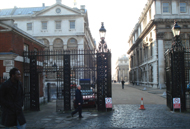
The East Gate - Queen Mary Court is seen on the left and Queen Anne Court on the right. King Charles Court can just be seen in the distance

Queen Mary Court and King William Court are seen on the left, and the end of Queen Anne Court on the right.
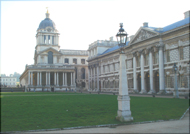
King William Court on the left and King Charles Court on the right, as seen from the riverside
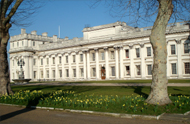
King William Court - western elevation
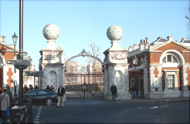
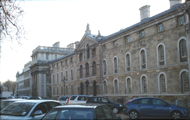
Queen Anne Court - eastern elevation

Queen Anne Court - western elevation
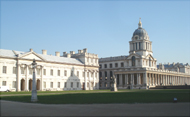
Queen Anne Court (left) and Queen Mary Court (right), as seen from the riverside

A passageway through Queen Anne Court
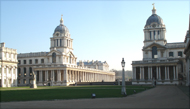
Queen Mary Court (left) and King William Court (right)
The west gate - King Charles Court and King William Court can be seen through the gateway
Trafalgar Quarters had been erected by the Hospital outside its grounds during 1813-16 for use as offices and storerooms. In 2001, the building was converted into sheltered housing, thus bringing pensioners back to the Hospital site
for the first time since 1869.
Trafalgar Quarters is now managed by the Church of England Soldiers', Sailors' and Airmen's Clubs.
for the first time since 1869.
Trafalgar Quarters is now managed by the Church of England Soldiers', Sailors' and Airmen's Clubs.
www.greenwich-guide.org.uk
www.nmm.ac.uk
www.oldroyalnavalcollege.org
www.portcities.org.uk
Return to home page